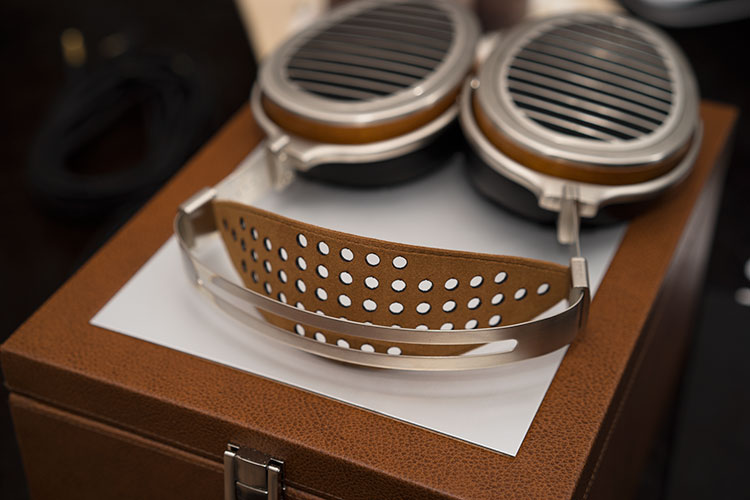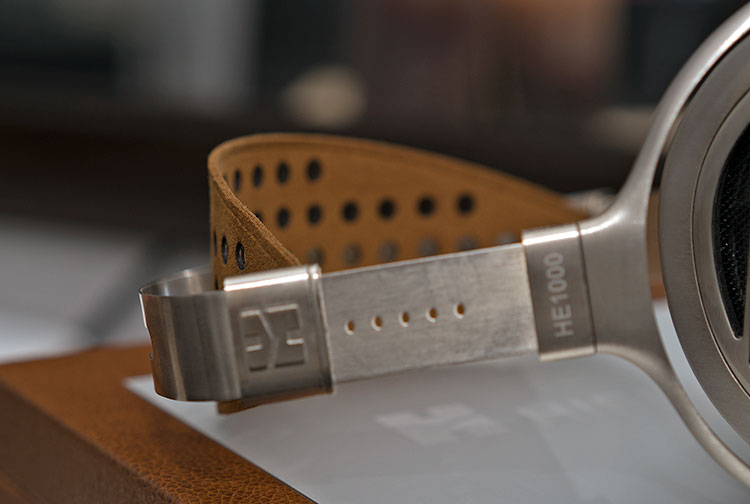Sound Impressions
Core Setup – ALO Audio Studio 6 and a combination of the NuPrime DAC-10 or the Continental Dual Mono for DAC duties. The source material was FLAC, DSD64, and DSD128 via JRiver Media Player/ASIO and Foobar WASAPI Push.
Summary
Hooked up to an ALO Audio Studio 6 tube amp and any number of good DAC combinations, such as the NuPrime DAC-10 and its ESS chip setup or the CDM from ALO Audio and its Wolfson implementation, the sound from the HE1000 is spectacular but varied.
This is a tonality that at its best flows effortlessly with bags of power and an almost bottomless depth to that bass extension. I was expecting open sure but not this revealing and spacious. It is very rare indeed you get a combination of this level of detail yet retains a high degree of musicality.
The tone is very organic and natural, especially with tube amps. The bonus of using the Studio 6 is that has a tighter more defined bottom end with the stock tubes, more so than regular tube amps which convey a traditional softer tube amp sound.
A hint of solid-state in many ways which the HE1000 laps right up to produce possibly the best distortion-free bottom ends I have heard in years.
Complimentary Tones
It is also the most refined of the Hifiman range I have heard to date and also easily the most resolving. That combination of detail and balance and a hint of sub-bass warmth, especially when combined makes the HE1000 a far more natural-sounding experience than the pinpoint analytical detail king, the HD800.
For me, it doesn’t quite overpower the HD800 in terms of imaging, soundstage width, and pinpoint detail retrieval but it is far more engaging with an instrumental timbre that I just find to be easily the more pleasing of the two.
There will be some die-hard HD800 fans that I cannot see dumping their precious for the HE1000 but for those with room to spare, I actually think both complement each other nicely at the flagship table.
Speed
Do not be fooled by the words smooth, natural, and flowing – this is no audio equivalent of a slow-moving cruise ship. The HE1000 technically has a very responsive and speedy signature.
There are no overly lengthy decay traits or overly rounded attacks in the HE1000’s signature. If you feed it metal it will keep up and give you a very precise reproduction from double kick drums to complex shredding solos.
If you feed it acoustics it can slow it down yet reproduce a very convincing sense of space and layering without ever sounding too dry or thin. This combination of control and musicality, for me, is what makes the tonality of the HE1000 very special indeed.
Bass Reach
This is perhaps the most impressive aspect of the HE1000 for me. The HE1k’s bass extends incredibly deep. I remember the first time I popped on the LCD-2 v1 in 2011 and listened to Mediæval Bæbes out of a Lehmann amp and my jaw dropped at how authoritative the sub-bass was and until now that has been my benchmark on sub-bass performance.
The HE1000 eclipses the Audeze sub-bass reach by some margin and extends way beyond the HE6 also for that matter.
The difference though comes in the impact and tonality of the bass performance between the two. The HE1000 bass on the whole is relatively neutral with a hint of warmth and linear in performance.
You will not find any mid-bass elevation or exaggeration in the curve, it is an almost straight line from 20-200hz with the mid-range showing no noticeable recession beyond up until 1k. It is that well-behaved and balanced.
I did say almost because right at the bottom, say 20-30hz there is the tiniest bit of elevation rather than rolled off and that makes a wonderful difference for me in the performance of the sub-bass giving the HE1000 a strong sense of heft right at the bottom where, for me, few headphones can go.
If anything you are going to “feel” this sub-bass as much as you will hear it. I remember my old ASW1000 sub from B&W (back as it was then and not Bowers & Wilkins) having that same effect.
I had previous subs in my home setup that gave me bass noise but nothing with a level of reach that not only gave me a proper sub-bass performance but at the same time allowed me to tweak my speaker setup to focus a lot more on mids and upwards.
Gone was the mush and the compromise with the ASW1k. The HE1k evokes that very same feeling I got with my home setup in terms of bass performance.
Bass Impact
Having said that the bass presented by the HE1k, vast it may be is not equally so in impact. I did mention linear in that respect and that includes little or no coloration meaning you will not get any artificial bumps on the way up.
Those looking for some bite or something more visceral and migrating from say the HE6 might be left a little wanting in that respect. Those hoping for an ocean of air being pushed in at mid-bass will also be left a little wanting also.
The HE1k bass is simply not presented in that fashion for me. It is tight, possessing oodles of sub-bass texture, and incredibly life-like sounding.
Grab “Ecce Chorus Virginum” by the Mediæval Bæbes for a really good example of how the HE1k bass responds. Right throughout there is a slow-paced bass drum underlying accompanying acoustic guitars and lead female vocals which are rather complex and ethereal. It shouldn’t overwhelm but at the same time give a very strong sense of depth.
The HE1000 delivers an incredibly low distortion-free response on this track that reproduces that bass drum as tight and deep as can be. The ability to define this drum and give it such gravitas without overwhelming the rest of the instruments is fantastic.
Mids
The mid-section of the HE1000 has a tiny dip post 1k to around 3k then it comes forward again from 4-7k into the upper mids and lower treble. I wouldn’t term the mids though as sounding recessed just not as forward or intimate in the lower range but possessing a very good vocal presence and an increased level of perceived energy in the upper mids.
It is perhaps that very slight dip in the lower mids that makes the vocals stand out a bit more. Instrumental spacing and timbre are excellent though, very natural and life-like in quality and articulation. Micro detail and clarity are excellent, especially on crunching rhythm and bass guitar work which has suitable weight and speed.
Vocals are wonderfully expressive and free of grain or sibilance though I wouldn’t term the HE1000 as an intimate headphone for vocals. Challenging breathy vocal sets from the likes of Buika and Laura Mvula, which can shoot out nasty sibilant trails with other brighter or harsher headphones, are perfectly balanced and natural on the HE1000.
Male soulful vocals such as Legend are on-song for me. “This Time” from Legend’s Evolver is beautifully presented and never once sounds lost or way back in the mix. The HE1000 excels with that type of vocal that is thick, throaty, or husky that lingers or whispers.
Perhaps my favorite experience with the HE1000 midrange and vocal performance has been with atmospheric recordings and Enya in particular. It is an excellent example of how to control ethereal delicate vocals in a very natural manner with a huge soundstage backdrop and a big orchestral backdrop.
Enya’s “May It Be” from The Lord of the Rings Trilogy is my ‘nailed-on favorite’ for emotive listening with the HE1000. Vocals positively soar without a hint of harshness in sight sounding incredibly fluid and detailed.
Treble
The treble performance of the HE1000 is perhaps where I met most of my challenges both good and not-so-good and it is all to do with the slight peak at the 7k level. Outside of that, the treble performance is excellent, articulate, and very incredibly detailed.
Ultimately I found my amp and DAC synergy to be one of the major factors in controlling this peak and allowing the HE1000 to play to its strengths rather than showcase any slight weakness it had in the treble performance.
Tubes worked better than solid-state unless it was inherently warm and rich, to begin with. ESS-equipped DACs brought a much higher level of resolution and clarity with the HE1000 treble but at the cost of a bit too much shine when things got energetic.
It was the smaller CDM from ALO Audio and its tube buffer and WM8741 implementation that brought a much smoother and musical top end to the HE1k. Not just with the Studio 6 but also with the EF6 and Mjolnir amps.
With this combination, I got great detail but calmer water even when things got energetic. It was only my CDM/Bakoon HPA-01M pairing that I also got fairly satisfying results in treble performance with metal genres though everything sounded a lot drier in doing so.
Genre Preferences
The second major factor and something that I think plays a role in understanding how the treble might play out on a personal level is genre selection itself, (combined with DAC and amp synergy).
I noticed quite a varying degree of commentary on the HE1000 peak, some barely noticing it and some making it a standout weakness and after testing differing genres I felt both are right.
With slower-paced genres, where vocals or midrange performances take center stage and a bit of top energy is taken out the HE1000 treble is beautiful. High notes are crystal clear and very well extended and it’s neither too harsh nor overly bright.
In this context, the 7k peak works to its favor helping to present a very airy and balanced tone with good headroom and a nice snap to percussion work.
However, load up the top end with high-energy rock, metal, and other sonic assaults where hi-hats and cymbals go into overdrive or synth work is extremely high pitched then the treble starts to get a bit sharp at the 7k to the point where it is much less natural and forgiving.
If anything it gave the impression that the HE1000 was not a headphone for high-energy melodic rock or anything that taps that range too hard. Rather the HE1000 treble seems to be much more at home with sparser arrangements that require a subtler presentation.
Click on page 3 below for our recommended pairings and selected comparisons.




